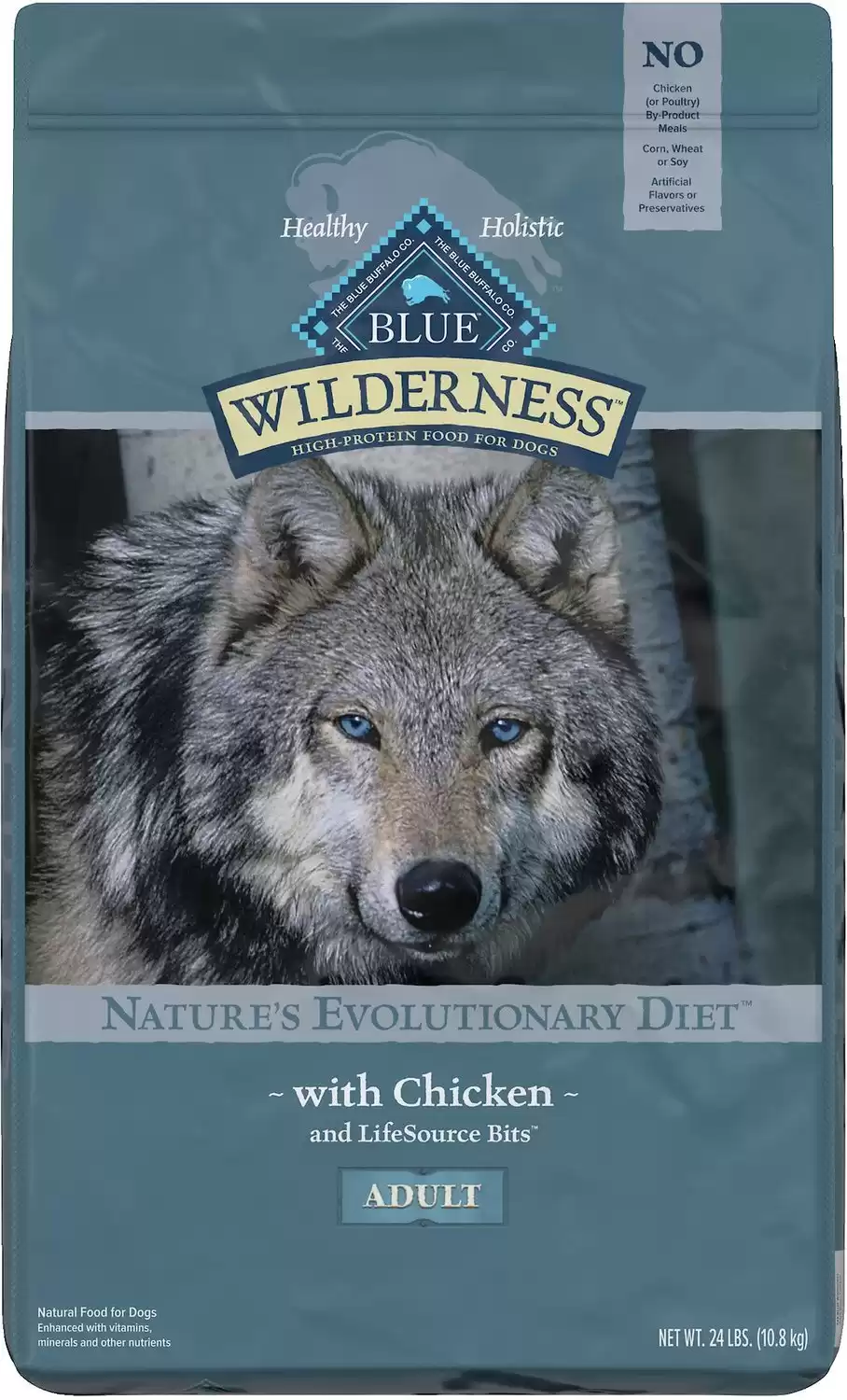Siberian Husky
Canis lupus
Is adequately warm in sub-zero temperatures!
Advertisement
Siberian Husky Scientific Classification
- Kingdom
- Animalia
- Phylum
- Chordata
- Class
- Mammalia
- Order
- Carnivora
- Family
- Canidae
- Genus
- Canis
- Scientific Name
- Canis lupus
Read our Complete Guide to Classification of Animals.
Siberian Husky Conservation Status
Siberian Husky Facts
Siberian Husky as a Pet:
- General Health
- Energy Level
- Shedability
- Trainability
- Intelligence
- Tendency to Chew
- Size
- Family and kid friendliness
- Yappiness / Barking
- Moderate
- Separation Anxiety
- High
- Preferred Temperature
- Cold climate
- Exercise Needs
- High
- Friendly With Other Dogs
- Group
- Pure bred cost to own
- $700 to $1200
- Dog group
- Working
- Male weight
- 35-60 lbs
- Female weight
- - lbs
This post may contain affiliate links to our partners like Chewy, Amazon, and others. Purchasing through these helps us further the A-Z Animals mission to educate about the world's species.
View all of the Siberian Husky images!
Siberian Huskies are the 12th most popular dog breed in the United States today, and it’s easy to see why.
This strikingly beautiful breed is one of the few that have blue eyes, and their lovely, thick coats come in a variety of colors such as grey and white, red and white, and agouti. They were originally bred in northeast Asia as both family pets and sled dogs, which is why they have such thick coats and high energy levels.
See all of our expert product reviews.
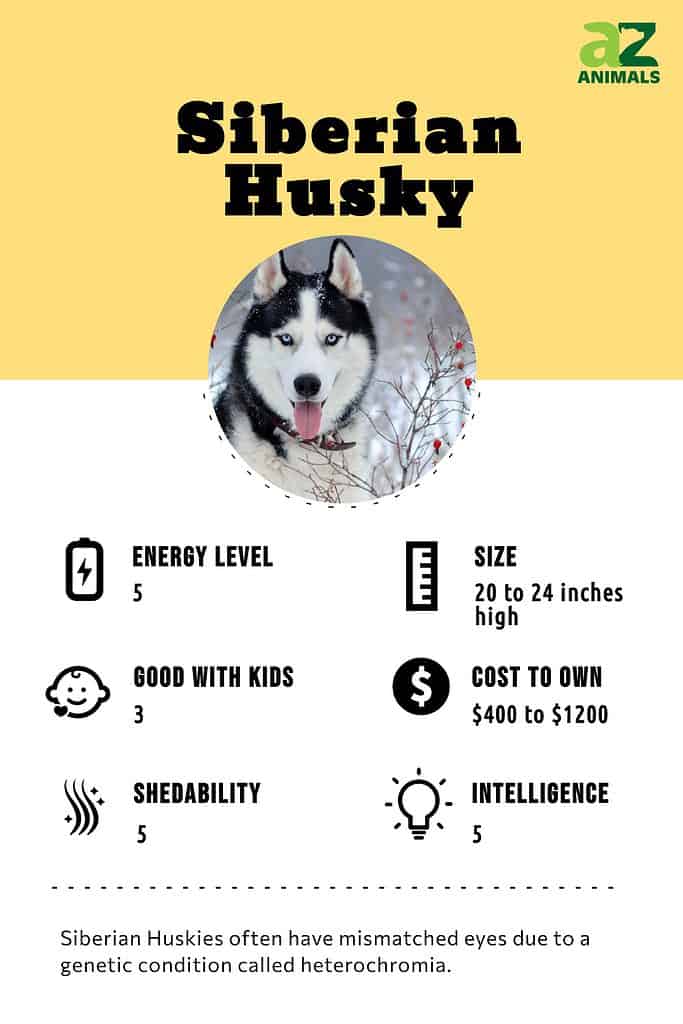
Over the years, the Siberian Husky has gotten a reputation for being hard to train due to their independent nature, but owners of this breed simply need to take charge with gentle confidence and consistent rules. Their demeanor is playful and friendly, and as such, they make lovely pets for the active family.
Siberian Huskies as Sled Dogs
History
The Siberian Husky breed originated in northeast Asia. These dogs were kept by the Chukchi people as both family pets and working sled dogs. At the turn of the 20th century, this breed gained notoriety for winning sledding races, but their real rise to fame began in 1925 when Gunnar Kaasen rushed medication to Nome, Alaska. His sled dog team raced 658 miles across the frozen tundra in 5 days to deliver the serum that would bring an end to the diphtheria epidemic. His lead sled dog, Balto, is still regarded as one of the greatest canine heroes of history and even has a commemorative statue in Central Park in New York City.
What Makes the Siberian Husky a Good Sled Dog?
Siberian Huskies have a lot of physical and temperamental traits that make them exceptional sled dogs. On the physical side, they have heavy, double-layered coats that keep them warm and dry in a snowy environment. They also have incredible endurance, which allows them to run great distances without tiring.
The temperamental trait that makes them great sled dogs is their innate ability to work as a pack. When the musher establishes themselves as leader of the pack, Siberian Huskies become eager to please their leader and work as a team to get the job done. These friendly dogs enjoy working closely with humans and other canines and rarely have any issues with aggression toward their packmates.
You can check out some incredible facts about Siberian Huskies.
Health and Entertainment for your Siberian Husky
See all of our expert product reviews.
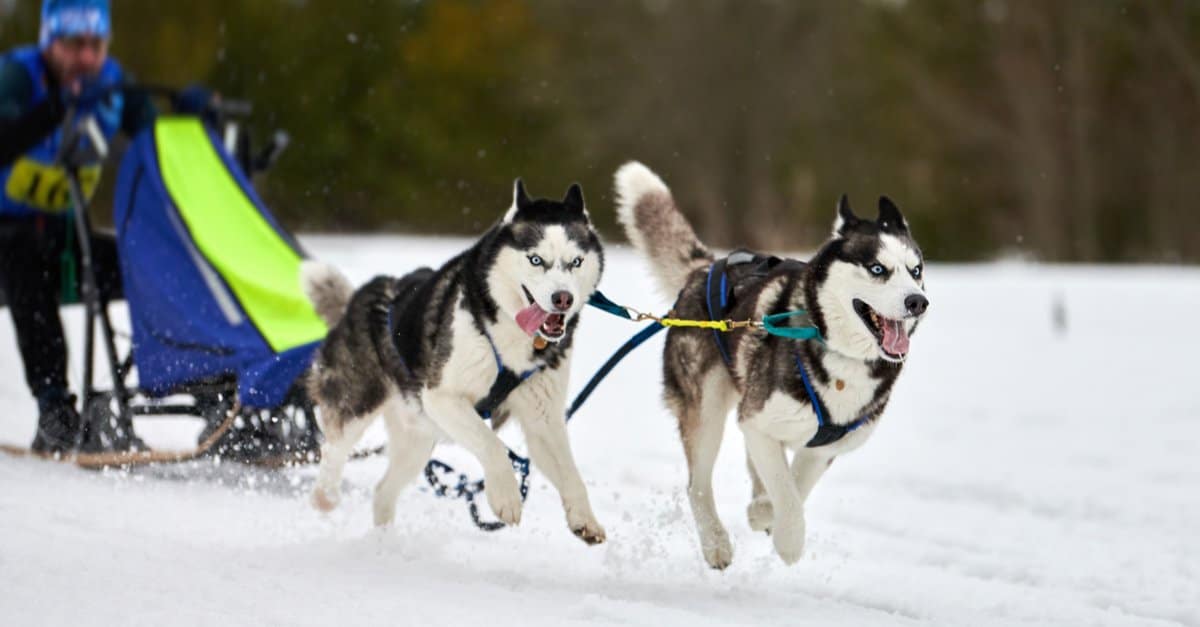
The Siberian Husky is well-known for pulling sleds through deep snow.
©travelarium.ph/Shutterstock.com
3 pros and cons of owning Siberian Husky
| Pros! | Cons! |
|---|---|
| Friendly and outgoing Their carefree nature makes introducing the Siberian Husky to new people a breeze. He is always happy to make a new friend. | Needs lots of attention Since they were bred for pack life, Siberian Huskies are miserable when separated from their families. If your lifestyle keeps you away from home without the ability to take your dog with you, this breed is not for you. |
| Low odor Siberian Huskies have very little if any of the unpleasant odor associated with many dogs. In fact, some people who are allergic to other dog breeds find that huskies don’t aggravate their condition. | Sheds an astronomical amount Huskies shed their undercoat twice a year in a process called “blowing.” Blowing lasts for about a month at a time. You’ll need to brush your dog every day during their shedding seasons to avoid swimming in hair. |
| Long lifespan The average husky lives for about 12-14 years, so you’ll have lots of time to spend with your furry companion. | Stubbornness makes them difficult to train Since huskies are highly intelligent and fiercely independent, they can be quite difficult to train. You must be consistent in your training and practice training techniques in all types of settings to earn your dog’s trust and respect. |

©Sbolotova/Shutterstock.com
Size and Weight
Siberian Huskies are considered medium-sized dogs. They stand between 20 and 24 inches high and can weigh anywhere from 35 to 60 pounds, with males being slightly larger than females.
Common Health Issues
The Siberian Husky is a healthy breed without many conditions to worry about. One common problem they face is juvenile cataracts. To reduce the occurrence of these cataracts, all Siberian Huskies that may be bred should have a thorough examination from a canine ophthalmologist every year.
Temperament
Siberian Huskies are highly intelligent and love the companionship of both humans and other dogs. This breed is outgoing, friendly, and trusting, and therefore will not make a good guard dog; they will accept any stranger as a new friend, which makes them incredibly ill-suited to protect the home. These dogs aren’t aggressive towards other dogs, which makes them an excellent fit for a multi-dog household. They do, however, have a high prey drive, so they shouldn’t share a home with cats or other small animals.
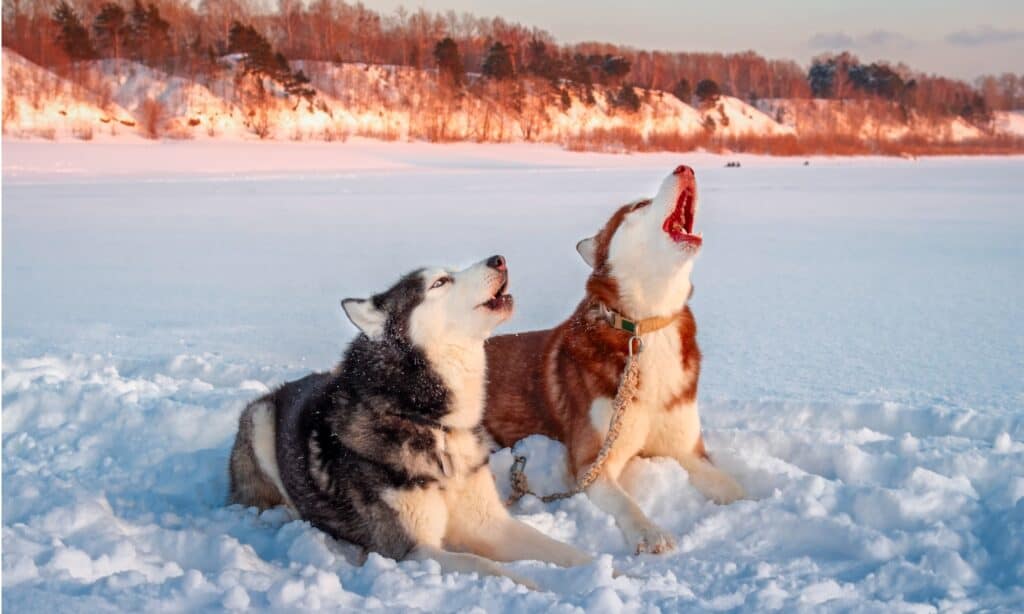
Siberian Huskies love attention and require a lot of exercise.
©iStock.com/Автор
Huskies are known for their strong wanderlust and independent nature when it comes to training, so even a well-trained husky should never be allowed off-lead unless they are in a securely fenced area with fences that are 6 feet or higher. They are also known diggers, so owners should consider burying concrete along their fence line to prevent their pets from digging out.
This breed requires copious amounts of attention and exercise and can become quite destructive without them. If you lead a sedentary life or spend a lot of time away from home, a Siberian Husky is not the right dog for you.
How To Take Care of a Siberian Husky
Training
Since these dogs are notoriously difficult to train, it would be beneficial to both dogs and owners to enroll in obedience classes. These dogs are working dogs and are happiest when they have a job to do, so harness training could be a fun activity for both dog and owner to enjoy together. It’s also important to note that no matter how well you think you’ve trained your husky that they are never allowed off-leash in an unsecured area. Many huskies end up as strays because their independence and wanderlust cause them to run from their masters.
Exercise
This breed is well-known for its high energy levels, so vets recommend a minimum of two hours of exercise each day. Huskies enjoy a wide variety of activities such as hiking, agility training or even just daily walks. You’ll want to take great care to get their energy out daily; a bored husky with pent-up energy can be quite destructive.
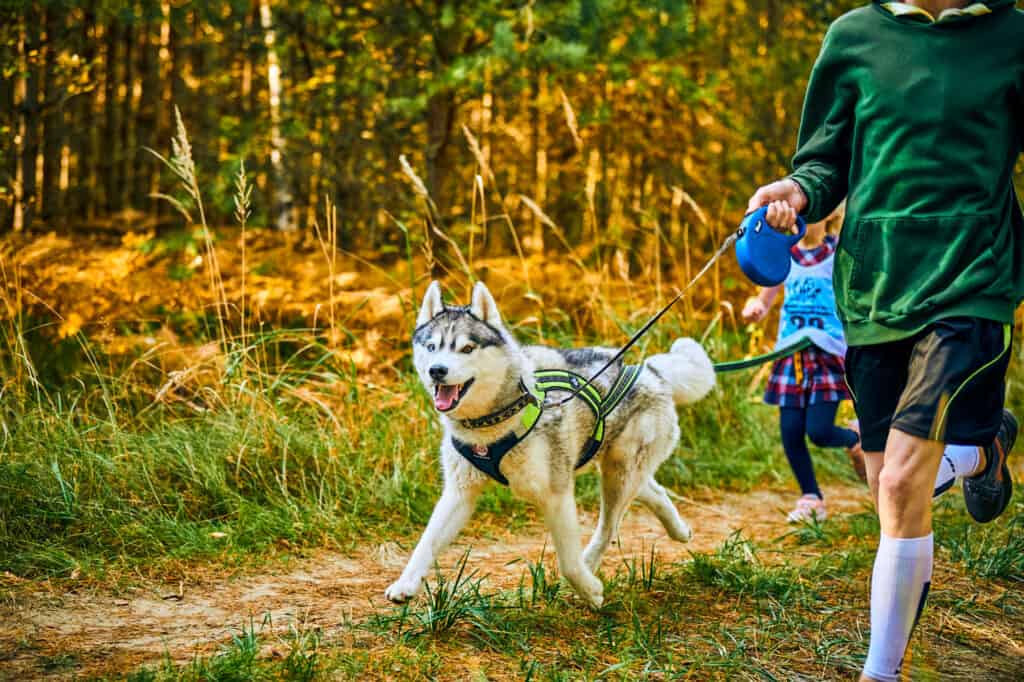
Siberian Huskies need plenty of exercise!
©iStock.com/TRAVELARIUM
Best Siberian Husky Insurance
Since the Siberian Husky is a purebred, it’s important to get pet insurance that covers common purebred problems, such as hip dysplasia.
Maintenance And Grooming
Siberian Huskies are relatively clean dogs that don’t have much of an odor, so they only require bathing a few times a year. They should be brushed weekly all year round to keep their coat looking healthy. They also lose their thick undercoats twice a year in a process called blowing, during which time they need to be brushed every day to prevent matting and a build-up of hair around the house.
Puppies

©Sbolotova/Shutterstock.com
Before you bring home your Siberian Husky puppy, you’ll need to make sure you have enough time to give him loads of affection and exercise. He will be full of energy and will need a good, secure space to play in. You’ll also need to be patient but consistent with training. If you can provide meet your pup’s needs in these areas, you can expect to have a friendly, outgoing companion for years to come.
The Best Dog Food for Siberian Huskies
Siberian Huskies benefit greatly from high-quality food. Their nutritional needs vary based on their activity levels. For example, if your dog is a family pet that only gets breed-required activity, he will only need a protein level of about 20 percent, but a working husky will need his protein level to be around 32 percent. Husky owners should work closely with a veterinarian to adequately meet their dog’s nutritional needs.
Luckily, Siberian Huskies are a generally healthy breed that’s not at particularly at risk for many health problems aside from cataracts. So it’s good to look for dog food with taurine and vitamin A for eye health, but Siberian Husky owners’ foremost priority should be giving their dog food that supports their extremely active lifestyle.
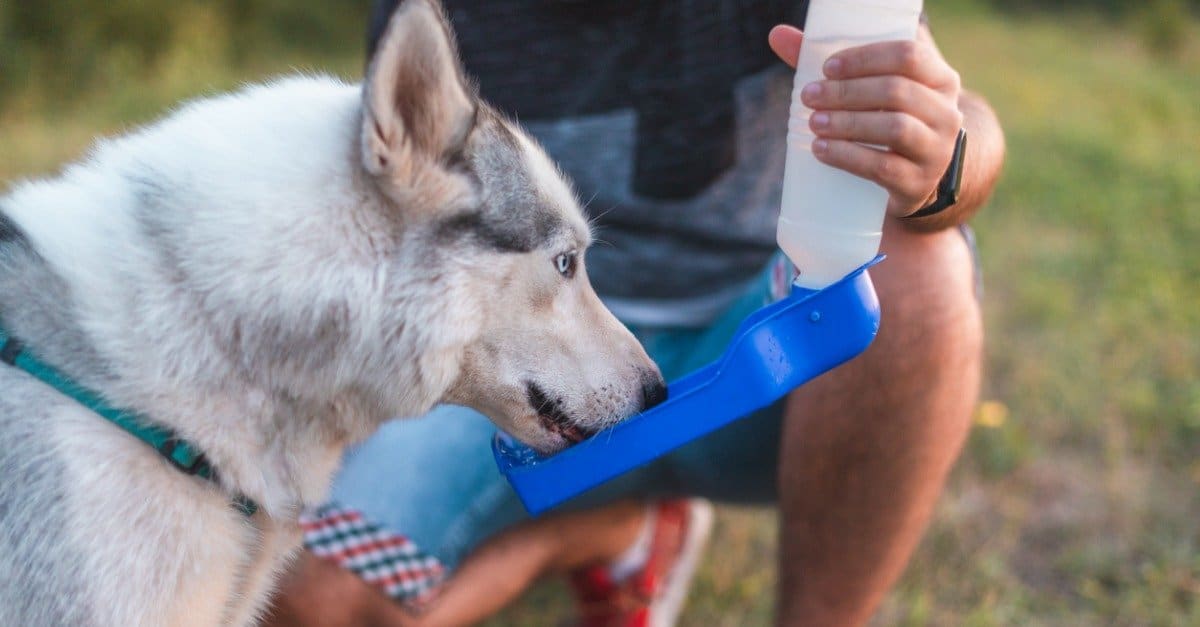
Portable water bottles are great options to give your dog water on road trips or out hiking.
©iStock.com/Luka Jankovic
Siberian Huskies that are working dogs may need an ultra high-calorie diet, but for pet huskies, Blue Buffalo Wilderness High Protein Natural Adult Dry Dog Food will do.
This natural ingredient dog food free from artificial preservatives contains extra lean muscle-building protein, healthy carbs, fatty acids, antioxidants, vitamins, and minerals for Siberian Huskies who are always on the move.
You can purchase Blue Buffalo Wilderness High Protein Natural Adult Dog Food by following this link. We also compiled a complete list of the best food for Siberian Huskies here.
- A high-protein recipe crafted with real deboned chicken first to help build and maintain lean muscle mass.
- Features glucosamine, chondroitin and EPA to support your dog’s joint function and overall mobility.
- Contains omega-3 and -6 fatty acids to support healthy skin and a lustrous coat.
- LifeSource Bits provide a precise blend of antioxidants, vitamins and minerals selected by holistic veterinarians and animal nutritionists to support immune system health, life stage requirements and healthy oxidative balance.
- Made with natural ingredients and 100% free from chicken (or poultry) by-product meals, corn, wheat, soy, artificial flavors and preservatives.
Siberian Huskies and Children
Due to their friendly, non-aggressive nature and energetic spirit, huskies make great pets for children. As with any breed, owners should teach both child and dog how to interact safely with each other and remember not to leave them unsupervised to prevent accidental injuries.
Dogs similar to the Siberian Husky
Other dog breeds that are similar to the Siberian Husky are the Alaskan Malamute, the Samoyed and the Akita.
- Alaskan Malamute
The Alaskan Malamute is slightly bigger than the Siberian Husky but has the same endurance level and friendly disposition. They are also a bit easier to train than huskies, which may make them a better fit for the first-time dog owner. - Chinook
The Chinook is a bit bigger than the Siberian Husky but has a less rambunctious nature than the husky. They are excellent with children and can be allowed off-leash with proper training. - Akita
The Akita is larger than the Siberian Husky and has a less outgoing personality, making them good guard dogs. They are affectionate with the humans in their family but tend to be aggressive toward other animals, which means they would do best in a single-pet household.
Famous Siberian Husky
The most famous Husky to date is Balto, the head sled dog who helped deliver medication to the isolated town of Nome, Alaska, during the diphtheria epidemic of 1925. With the guidance of expert musher Gunnar Kaasen, Balto lead his pack across the tundra through a blizzard to bring an end to the outbreak.
Popular Names for Siberian Huskies
A few popular names for these Huskies are:
- Loki
- Koda
- Dakota
- Zeus
- Apollo
- Luna
- Sky
- Bella
- Nova
- Akira
Up Next
- 10 Incredible Siberian Husky Facts
- Why Do Siberian Huskies Have Blue Eyes?
- Siberian Husky vs Wolf: 5 Key Differences
Siberian Husky FAQs (Frequently Asked Questions)
Is a Siberian Husky a good family dog?
Siberian Huskies are incredibly friendly dogs with high energy levels. These traits make them a great fit for an active family.
Is the Siberian Husky dangerous?
Although Siberian Huskies may look dangerous, in reality, they are quite friendly. Huskies make horrible guard dogs because they would sooner befriend a stranger than attack them. This breed loves nothing more than meeting a new playmate. Proper training and socialization from a young age, paired with adequate exercise to prevent frustration, will keep your husky from developing aggression.
How much does a Siberian Husky cost?
Some breeders charge up to $2,000 for a pup from expertly-developed bloodlines, but the average price is between $700 to $1200. If you’d prefer to adopt a Siberian Husky from a shelter, you will likely only pay between $200 and $400 in rehoming fees.
How do you train a Siberian husky?
To train a Siberian Husky, you’ll need to be gentle yet firm and consistent with the rules from puppyhood. Huskies are notoriously stubborn, so if you go easy on one rule, they will decide that all rules are flexible. It is a good idea to enroll your husky puppy into obedience classes at an early age to develop a level of trust and respect between dog and owner.
What is the difference between a Siberian Husky and an Alaskan Husky?
The main difference between the Siberian Huskies and Alaskan Huskies is that the Siberians are purebred dogs whose bloodlines go back thousands of years; Alaskan Huskies are mixed breed dogs created by Canadian and Alaskan mushers as strict working dogs. This difference in breed creation directly correlates to all the differences between the two types of dogs. Since they were bred solely for work, the Alaskans tend to be slightly more aloof and less suited for family life than their Siberian cousins. Alaskans also shed a bit less because their coats aren’t as long and thick as the Siberians. Both dogs are quite friendly and would not make good guard dogs due to their trusting nature.
There are minor differences in appearance between the Siberian Husky and the Alaskan Husky as well. While both dogs can have either brown or blue eyes and feature a variety of colors such as grey and white, red and white, or agouti, Alaskan Huskies can also be solid black or solid white.
Since the Siberian Husky is an AKC-recognized purebred, they will have a higher purchase price than their mixed-breed Alaskan cousins.
What is a Miniature Husky?
Miniature Huskies are smaller sized standard huskies. Expert breeder Bree Normandin started this breed by continually pairing the smallest Siberian Huskies together to create the miniature huskies of today. This tiny husky variant is more suited to life as a companion than as a working dog.
Are Siberian Huskies herbivores, carnivores, or omnivores?
Siberian Huskies are Omnivores, meaning they eat both plants and other animals.
What Kingdom do Siberian Huskies belong to?
Siberian Huskies belong to the Kingdom Animalia.
What phylum to Siberian Huskies belong to?
Siberian Huskies belong to the phylum Chordata.
What class do Siberian Huskies belong to?
Siberian Huskies belong to the class Mammalia.
What family do Siberian Huskies belong to?
Siberian Huskies belong to the family Canidae.
What order do Siberian Huskies belong to?
Siberian Huskies belong to the order Carnivora.
What type of covering do Siberian Huskies have?
Siberian Huskies are covered in Hair.
What genus do Siberian Huskies belong to?
Siberian Huskies belong to the genus Canis.
What is an interesting fact about Siberian Huskies?
The Siberian Husky is adequately warm in sub-zero temperatures!
What is the scientific name for the Siberian Husky?
The scientific name for the Siberian Husky is Canis lupus.
What is the lifespan of a Siberian Husky?
Siberian Huskies can live for 14 years.
What's the difference between the Siberian Husky and the Alaskan Klee Kai?
The Alaskan Klee Kai is much smaller than the Siberian Husky. Additionally, the Siberian Husky is a working breed of dog, while the Alaskan Klee Kai is a companion animal breed.
What are the differences between Siberian Husky and Golden Retriever?
The key differences between the Siberian Husky and the Golden Retriever are their size, appearance, lifespan, energy level, watchdog instincts, trainability, and tendency to bark.
What are the key differences between the Samoyed and Siberian Husky?
The key differences between Samoyeds and Siberian Huskies include size, appearance, coat length, coat color, guarding behavior, trainability, energy level, grooming needs, shedding, and dog tolerance.
What's the difference between a Siberian Husky and a Wolf?
The wolf grows larger than the Siberian Husky, and the Husky is domesticated, while the wolf is wild. Finally, the wolf tends to match its environment, while the Siberian Husky only comes in select colors and markings.
What are the differences between the Alaskan Malamute and the Siberian Husky?
The major differences between the Alaskan Malamute and the Husky are found in their size and lifespan.
Thank you for reading! Have some feedback for us? Contact the AZ Animals editorial team.
Sources
- David Burnie, Dorling Kindersley (2011) Animal, The Definitive Visual Guide To The World's Wildlife
- Tom Jackson, Lorenz Books (2007) The World Encyclopedia Of Animals
- David Burnie, Kingfisher (2011) The Kingfisher Animal Encyclopedia
- David Burnie, Dorling Kindersley (2008) Illustrated Encyclopedia Of Animals
- Dorling Kindersley (2006) Dorling Kindersley Encyclopedia Of Animals
- American Kennel Club, Available here: https://www.akc.org/dog-breeds/siberian-husky/
- Siberian Husky Rescue of Florida, Inc., Available here: http://www.siberrescue.com/huskyed4.html
- AKC, Available here: https://www.akc.org/expert-advice/lifestyle/10-facts-siberian-huskies/
- Spirit Dog Training, Available here: https://spiritdogtraining.com/breeds/types-of-huskies/





